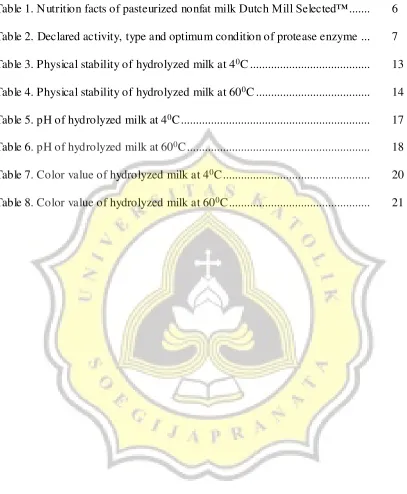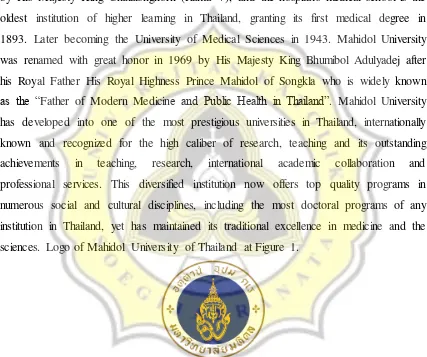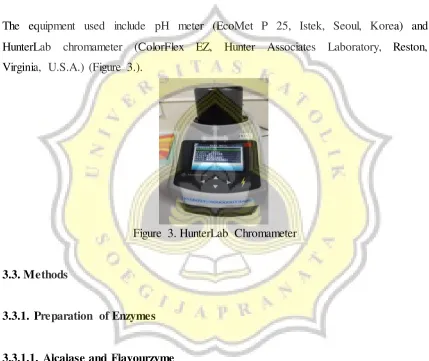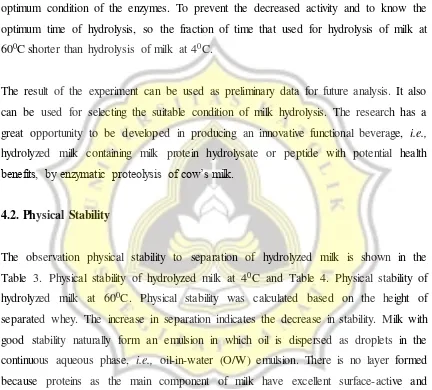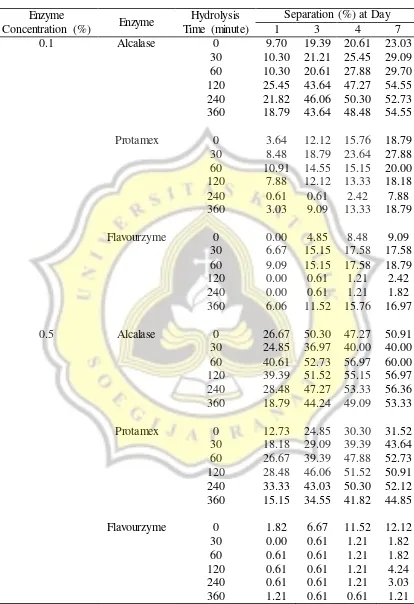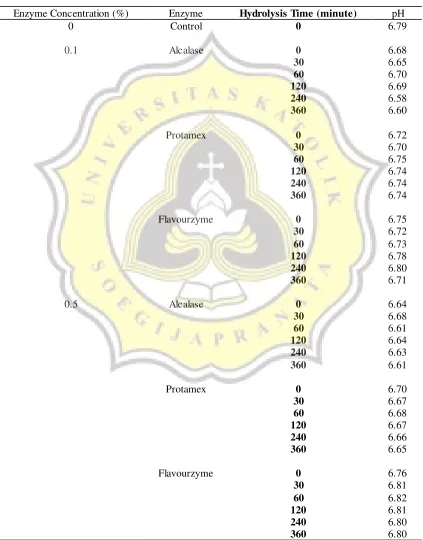THE EFFECT OF ENZYMATIC HYDROLYSIS CONDITION
ON PHYSICAL O
F COW’S MILK
PRACTICAL TRAINING REPORT
This practical training report is submitted for the partial requirement for Bachelor Degree
By :
Carolina Santoso 14.I1.0036
DEPARTMENT OF FOOD TECHNOLOGY
FACULTY OF AGRICULTURAL TECHNOLOGY
SOEGIJAPRANATA CATHOLIC UNIVERSITY
SEMARANG
i
The Effect of Enzymatic Hydrolysis Condition on Physical of
Cow’s Milk
BY:
CAROLINA SANTOSO Student ID : 14.I1.0036 Faculty of Agricultural Technology
This practical training report has been approved and supported by examiner in Practical Training Exam on June 8th, 2017
Department of Food Technology Faculty of Agricultural Technology Soegijapranata Catholic University
Semarang, 8 Juni 2017 Technical Advisor I Technical Advisor II
Dr. Nattapol Tangsuphoom, Ph.D. Dr. Ir. Lindayani, MP
Dean
ii PREFACE
First of all the writer would like to express her thanks to God because of His grace this practical training report entitled “The Effect of Enzymatic Hydrolysis Condition on Physical of Cow’s Milk” could be completed. This practical training report was written as part of the practical training of Carolina Santoso at Institute of Nutrition Mahidol University. The practical training was under supervision of Dr. Nattapol Tangsuphoom, Ph.D. and Dr. Ir. Lindayani, MP and took place between January 10th to March 9th, cross-cultural and social awareness.
The writer recognized that there were many mistakes during the experiment and there were many lacks of arranging this practical training report. The writer would like to give special thanks to :
1. Dr. V. Kristina Ananingsih, ST., MSc. as Dean of Faculty of Agricultural Technology Soegijapranata Catholic University, thank you for giving information and opportunity to join practical training.
2. Assoc. Prof. Dr. Ratchanee Kongkachuichai as Director of Institute of Nutrition Mahidol University, thank you for your providing me the opportunity to do practical training in your faculty.
3. Dr. Nattapol Tangsuphoom, Ph.D. as the first advisor, thank you for your time, guidance, direction, encouragement, suggestion, patience, correlation, advice, and idea that have been shared to me which very enriched my knowledge and was very helpful to finish this report.
iii
5. Nitjaree Maneerat, M.Sc. as laboratory partner, thank you for taking time to accompany me, share your knowledge, experience, and always be patient to me. 6. Angela Irena Wibawa, thank you for your smiles, laughter, and support. You really
motivate me become a single fighter who is not afraid to try something new.
7. Bambang Hadisantoso and Lay Njuk Siu as my parents, also my sisters Deissy
Roosalia Santoso and Grace Giovanni Santoso, thank you for your love, prayer, advice, guidance, and support emotionally and financially. Your love is beyond any words.
8. Onny Shelvia as a roommate, thank you for our togetherness.
9. All of people who had directly and indirectly helped and supported during the practical training until finishing the report.
Finally, may God receives all their works and kindnesses. The readers also can give suggestions to the writer to improve the content in order to make this report be one of the good examples for the next practical training.
Semarang, 8 Juni 2017
iv
1.1.1.1. Institute of Nutrition Mahidol University ... 1
1.1.1.2. Vision... 2
1.1.1.3. Mission ... 2
1.1.2. Purpose of Practical Training ... 3
1.1.3. Time and Place of Practical Training ... 3
4.1. Determination of Time and Temperature Hydrolysis ... 11
v
LIST OF TABLES
Table 1. N utrition facts of pasteurized nonfat milk Dutch Mill Selected™ ... 6
Table 2. Declared activity, type and optimum condition of protease enzyme ... 7
Table 3. Physical stability of hydrolyzed milk at 40C ... 13
Table 4. Physical stability of hydrolyzed milk at 600C ... 14
Table 5. pH of hydrolyzed milk at 40C ... 17
Table 6. pH of hydrolyzed milk at 600C ... 18
Table 7. Color value of hydrolyzed milk at 40C ... 20
vi
LIST OF FIGURES
Figure 1. Logo of Mahidol University of Thailand ... 1 Figure 2. Pasteurized Nonfat Milk Dutch Mill Selected™ ... 6
vii
LIST OF APPENDIXES
Appendix 1. Institute Members ... 26 Appendix 2. Place of Practical Training ... 27 Appendix 3. List of Attendance ... 28
1
1. INTRODUCTION
1.1. Practical Training
1.1.1. Mahidol University
Mahidol University (MU) has its origins in the establishment of Siriraj Hospital in 1888 by His Majesty King Chulalongkorn (Rama V), and the hospital's medical school is the oldest institution of higher learning in Thailand, granting its first medical degree in 1893. Later becoming the University of Medical Sciences in 1943. Mahidol University was renamed with great honor in 1969 by His Majesty King Bhumibol Adulyadej after his Royal Father His Royal Highness Prince Mahidol of Songkla who is widely known
as the “Father of Modern Medicine and Public Health in Thailand”. Mahidol University has developed into one of the most prestigious universities in Thailand, internationally known and recognized for the high caliber of research, teaching and its outstanding achievements in teaching, research, international academic collaboration and professional services. This diversified institution now offers top quality programs in numerous social and cultural disciplines, including the most doctoral programs of any institution in Thailand, yet has maintained its traditional excellence in medicine and the sciences. Logo of Mahidol University of Thailand at Figure 1.
Figure 1. Logo of Mahidol University of Thailand
1.1.1.1. Institute of Nutrition Mahidol University
2
among other nutrition and nutrition-related institutions due to its dedication to health and medical sciences, advanced facilities and technologies and the high level of expertise shown by its faculty in food and nutrition. Since its founding Institute of Nutrition Mahidol University has fulfilled this mission by conducting research at community and laboratory levels, providing national and international training and education programs, and providing technical services in food and nutrition development. The goal has been and continues to be, the attainment of the highest possible quality of life for individuals, communities, Thai society, and for people living in other countries within and outside the Southeast Asian Region.
1.1.1.2. Vision
Institute of Nutrition Mahidol University strives to become a top-leading research institution on food and nutrition in ASEAN by 2020, through innovative research, capacity building and the generation and transfer of advanced knowledge and technologies to effectively address critical food and nutrition challenges at individual, community, national and global levels.
1.1.1.3. Mission
3
1.1.2. Purpose of Practical Training
The main purpose of practical training are in follow:
a. To give an experience to explore food in the research, so the student can implement the knowledge that they learned in the scientist world or real food industry.
b. To give an opportunity to adapt with new circumstances and neighborhood. c. To broaden the knowledge and experience of international exposure.
1.1.3. Time and Place of Practical training
4
2. BACKGROUND OF RESEARCH
Milk is consumed by billions of people around the world every day because it is nutritious. Milk contains numerous nutrients such as calcium, selenium, magnesium, vitamin B5, vitamin B12, and riboflavin that give significant contribution to human the action of digestive proteases or via proteolysis occurs during fermentation (Silva and Malcata, 2005; Nagpal et al., 2012). The major proteins found in milk are casein
and whey proteins. Casein (αs1-, αs2-, β-, and κ-casein) contributing about 78% of the total protein; while whey proteins contributing about 17% of the total protein. The main
whey proteins are glycomacropeptide, immunoglobulins, serum albumin, α-lactalbumin,
and β-lactoglobulin; minor proteins include lactoferrin, insulin growth factor, and the lactoperoxidase system (Molgaard et al., 2011). Not all milk has the same composition; it is greatly influenced by the health of animal, age, feed, seasonal variations, stage of location, number of parturitions, breed differences, or management effects (FAO , 2013).
5
However, not all rejected milk is spoiled, unsafe or not worth drinking. Actually, most of the sub-standard milk can still be further processed to produce other by products that are safe and value-added, due to their improved functions and health benefits. It is necessary to determine the appropriate processing technology to increase the value of the milk, which will also help in reducing food loss and food waste.
This experiment is a preliminary experiment to determine the changes in physical properties, i.e., pH, color, and physical stability of cow’s milk hydrolyzed by different protease enzymes under different hydrolysis conditions. Hydrolysis of protein may poses some biochemical properties that are beneficial for health such as antioxidant activities, inhibitory activities on some key enzymes related to non-communicable diseases and milk will be more easily digested by digestive system. The information obtained from this study will be useful in selecting the suitable condition, and assessing the possibility for the production of an innovative functional beverage, i.e., hydrolyzed milk containing milk protein hydrolysate or peptide with potential health benefits, by
6
3. RESEARCH METHODOLOGY
3.1. Materials
Pasteurized non-fat milk (Dutch Mill Selected™, Dairy Plus, Bang Rak, Bangkok, Thailand) was purchased from a local supermarket (Figure 2.). Its nutrient composition, obtained from nutrition fact panel, is listed in Table 1. Three kinds of protease enzymes were used for hydrolysis, including Alcalase 2.4L, Protamex 1.5MG and Flavourzyme 1000L. The enzymes were donated from Brenntag Ingredients (Bangkok, Thailand). Information of protease enzymes as obtained from supplier is presented in Table 2. Technical buffer solutions pH 4, 7, and 10 were purchased from Mettler-Toledo (Bangkok, Thailand). All other chemicals were obtained from Sigma-Aldrich (St. Louis, Missouri, U.S.A.).
Figure 2. Pasteurized Nonfat Milk Dutch Mill SelectedT M
Table 1. Nutrition facts of pasteurized nonfat milk Dutch Mill Selected™
Composition Content
Total energy (kcal/100ml) 35
Protein (g/100ml) 3
Fat (g/100ml) 0
7
Table 2. Declared activity, type and optimum condition of protease enzyme
Protease Declared
Activity Type
Optimum condition pH Temperature (°C)
Alcalase 2.4L 2.4 AU/g Endopeptidase 9 50-55
Protamex 1.5MG 1.5 AU/g Endopeptidase 8 50-55
Flavourzyme1000L 1 LAPU/g Endo-exopeptidase 7 50-55
3.2. Equipments
The equipment used include pH meter (EcoMet P 25, Istek, Seoul, Korea) and HunterLab chromameter (ColorFlex EZ, Hunter Associates Laboratory, Reston, Virginia, U.S.A.) (Figure 3.).
Figure 3. HunterLab Chromameter
3.3. Methods
3.3.1. Preparation of Enzymes
3.3.1.1. Alcalase and Flavourzyme
Diluted 100 μl of Alcalase 2.4L and Flavourzyme 1000L with addition of phosphate buffer pH 8.2 as many as 900 μl to obtain 10% concentration of
9
cooling down immediately to room temperature in an ice bath. The hydrolyzed milk samples were kept in a refrigerator for further analyses.
3.3.2.1. Hydrolysis at 4°C
Prepared 18 tubes each containing 40 ml of milk. After that added enzymes to
the milk (to obtain 0.1% concentration of enzyme took 120 μl of 1%
concentration of enzyme and to obtain 0.5% concentration of enzyme took 60
μl of 10% concentration of enzyme). Fractions were taken at 0, 30, 60, 120,
240, and 360 minutes for analyses and keep on refrigerator at 4°C. Each fraction was heated around 95ºC for 5 minutes to inactivate the enzyme, followed by cooling down immediately at room temperature in ice bath. The milk was kept in a refrigerator for further analyses.
3.3.2.2. Hydrolysis at 60°C
Prepared 18 tubes each containing 40 ml of milk. Incubated the milk at 60ºC for 30 minutes. After that added enzymes to the milk (to obtain 0.1% concentration
of enzyme took 120 μl of 1% concentration of enzyme and to obtain 0.5%
concentration of enzyme took 60 μl of 10% concentration of enzyme). The hydrolysis was conducted at 60ºC for 30 minutes in a temperature-controlled water bath. Fractions were taken at 0, 20, 40, 60, 90, and 120 minutes for analyses. Each fraction was heated around 95ºC for 5 minutes to inactivate the enzyme, followed by cooling down immediately at room temperature in ice bath. The milk was kept in a refrigerator for further analyses.
3.3.3. Analyses
10
3.3.3.1. Physical Stability
Observed the occurrence of separation and measured the height of each layer during storage in screw-capped glass test tubes under refrigeration for 0-7 days (measured everyday if possible).
3.3.3.2. pH
Measured the pH of solution by pH meter, which had been calibrated with buffer solution pH 4, 7, and 10.
3.3.3.3. Color
11 4. RESULTS AND DISCUSSION
The main component of milk is protein. Protein has complex structure that is made up of chains of amino acids linked by peptide bonds. Hydrolysis is a method to break the peptide bonds, resulting free amino acids. There are several hydrolysis methods, such as acid hydrolysis, enzymatic hydrolysis, microbial hydrolysis, and autolysis. Enzymatic hydrolysis is the hydrolysis method that use proteolytic enzyme, which does not require high temperature and can specifically break the peptide bonds. The result of proteolytic digestion is a mixture of amino acids and polypeptides in varying lengths (BD Biosciences, 2009). Cleavage of protein structure may result in the changes in physical properties of milk, which my consequently affect the quality and consumer acceptability of the product. Therefore, in this study, the changes in physical properties including physical stability, pH, and color of milk were monitored during hydrolysis.
4.1. Determination of Time and Temperature Hydrolysis
12
The fraction of time for both temperatures were different. This is due to the different method that used for hydrolysis. The milk was incubated at 600C for 30 minutes before additon of enzyme. This method was applied for hydrolysis at 600C, but not for hydrolysis at 40C. The time of incubation and the hydrolysis temperature at 600C slightly above the optimum temperature of the enzymes, this may result in decreased activity of the enzymes because longer time contact with heat condition above the optimum condition of the enzymes. To prevent the decreased activity and to know the optimum time of hydrolysis, so the fraction of time that used for hydrolysis of milk at 600C shorter than hydrolysis of milk at 40C.
The result of the experiment can be used as preliminary data for future analysis. It also can be used for selecting the suitable condition of milk hydrolysis. The research has a great opportunity to be developed in producing an innovative functional beverage, i.e., hydrolyzed milk containing milk protein hydrolysate or peptide with potential health
benefits, by enzymatic proteolysis of cow’s milk.
4.2. Physical Stability
15 hydrolysis at different temperatures. At any hydrolysis temperature, addition of 0.5% concentration of enzyme can work faster the hydrolysis activity than addition of 0.1% concentration of enzyme, because there was more substrate (protein) that reacted with the enzyme and there was more protein hydrolyzed to peptides and free amino acids within a certain period. To stop the reaction, enzyme must be inactivated with high temperature (95°C, 5 minutes). Thermal treatment can lead to protein denaturation due to conformational change and results in aggregation of protein and precipitation. Protein can control the stability and overall appearance of food emulsions (Sun and Gunasekaran, 2010). Therefore, the hydrolysis of protein made the emulsion of milk destabilize and form layers or separation between water and oil fractions.
16
effect of hydrolysis by each enzyme was different. Alcalase, Protamex, and Flavourzyme had different optimum pH and specific activity to hydrolyze protein. With all conditions in the experiment, Alcalase had the greatest activity to hydrolyze protein in milk, and thus the milk which was hydrolyzed by Alcalase had the lowest stability and the percentage of whey separation was the highest at any hydrolysis conditions. Day by day, the layer of separation was more observable. The percentage of whey increased but the percentage of curd decreased. It indicated that there was more protein that hydrolyzed by the enzymes. It also indicated that the milk might spoiled during storage because the thermal treatment used to inactivate the enzyme was insufficient to kill the spoilage microorganisms. Therefore, proteolysis might took place by microorganisms and caused the further decrease in pH of milk samples, change in pH could be the major cause of decrease in physical stability of the samples during storage.
17
4.3. pH of Hydrolyzed Milk
The pH of hydrolyzed milk is shown in the Table 5. pH of hydrolyzed milk at 40C and and Table 6. pH of hydrolyzed milk at 600C.
Table 5. pH of hydrolyzed milk at 40C
Enzyme Concentration (%) Enzyme Hydrolysis Time (minute) pH
18
Table 6. pH of hydrolyzed milk at 600C
Enzyme Concentration (%) Enzyme Hydrolysis Time (minute) pH
20
21
Table 8. Color values of hydrolyzed milk at 600C
22
darker. For milk hydrolyzed at 60°C, Alcalase at both concentrations (0.1% and 0.5%) affected the most L* value or lightness of the milk. Hydrolysis with Flavourzyme at any concentration decreased the L* value the least. For Protamex, hydrolysis with 0.1% concentration of enzyme did not affect the L* while the effect was more noticeable when the enzyme concentration increased to 0.5%. In sequence, the samples with L* value from darkest to lightness were those hydrolyzed with Alcalase, Protamex, and Flavourzyme.
The a* value of natural milk was -3.64, suggesting the greenness. For milk hydrolyzed at 60°C, a* value tended to decrease regardless of hydrolysis condition, suggesting that the hydrolyzed milks were greener. The most change in a* value was observed in the samples hydrolyzed with Alcalase. Similarly, hydrolysis at 4°C decreased the a* value of milk. Considering the effect of hydrolysis time, it was found that the longer hydrolysis time resulted in the more decrease in a* value. The b* value of natural milk was 12.46, suggesting the yellowness. The effect of hydrolysis condition on b* value of milk was negligible.
23 5. CONCLUSION AND SUGGESTION
5.1. Conclusion
The hydrolysis activity at 4°C and 60°C quite the same due to the reactivity was not very sensitive to the temperature and minor changes were observed (physical, pH and color). It greater used 0.5% of enzyme concentration than 0.1% of enzyme concentration. The longer hydrolysis time there are more protein hydrolyze by the enzymes, there are more clear layer separation, lower pH, and the color tend to greenness-blue. The highest to the lowest hydrolysis activity are Alcalase, Protamex, and Flavourzyme.
5.2. Suggestion
24 6. REFERENCES
Hughes, A. B. (Ed). (2011). Amino Acids, Peptides and Proteins in Organic Chemistry, Volume 5, Analysis and Function of Amino Acids and Peptides. Wiley-VCH.
BD Biosciences. (2009). Hydrolysis to Hydrolysate. Advanced Bioprocessing. America.
Matijevic, B., Lisak, K., Bozanic R., Tratnik, L. (2011). Impact of Enzymatic Hydrolyzed Lactose on Fermentation and Growth of Probiotic Bacteria in Whey. Probiotic Bacteria in Whey. Vol 61(2): 154-160.
Sun, Changhui & Gunasekaran, S. (2010). Rheology and Oxidative Stability of Whey Protein Isolate-Stabilized Menhaden Oil-in-Water Emulsions as a Function of Heat Treatment. Journal of Food Science. Vol 75(1): C1-C8.
NDDB. (2009). Code of Hygienic Practice for Milk and Milk Products. National Dairy Development Board. India.
FAOSTAT. (2017). FAO Statistical Database. Available at: http://faostat.fao.org/. Accessed 28 February 2017.
Food and Agriculuture Organization. (2013). Milk and Dairy Products in Human Nutrition. Food and Agriculuture Organization of The United Nations. Rome.
Kanwar, J.R., Kanwar, R.K., Sun, X., Punj, V., Matta, H., Morley, S.M., Parratt, A., Puri, M. & Sehgal R. (2009). Molecular and Biotechnological Advances in Milk Proteins in Relation to Human Health. Current Protein and Peptide Science. Vol 10(4): 308–338.
25
Rybak, Olga. (2013). Some Aspects of the Formation of Emulsions and Foams in Food Industry. Ukrainan Journal of Food Science. Vol 1(1): 41-49.
Silva, S. V. & F. Xavier Malcata. (2005). Caseins as Source of Bioactive Peptides.
26 7. APPENDIX
Appendix 1. Insititute Members
The main administrators of the faculty are as follow: a. Director: Assoc. Prof. Dr. Ratchanee Kongkachuichai.
b. Deputy Director for Policy and Planning: Ms. Rin Charoensiri. c. Deputy Director for Education: Asst. Prof. Dr. Chanida Pachotikarn.
d. Deputy Director for Research and International Affairs: Asst. Prof. Dr. Kitti Sranacharoenpong.
e. Deputy Director for Resources and Environment: Asst. Prof. Dr. Aikkarach Kettawan.
f. Head of Food Cluster: Assoc. Prof. Dr. Pornrat Sinchaipanit.
g. Head of Nutrition Cluster: Assoc. Prof. Dr. Nipa Rojroongwasinkul.
h. Head of Center of Innovation and Reference on Food for Nutrition: Dr. Chalat Santivarangkna.
i. Chair of M.Sc. and Ph.D. Programs in Nutrition: Assoc. Prof. Dr. Nalinee Chongviriyaphan.
j. Chair of M.Sc. Program in Food and Nutritional Toxicology: Asst. Prof. Dr. Chaniphun Butryee.
k. Chair of M.Sc. Program in Food Science for Nutrition (International Program): Asst. Prof. Dr. Sitima Jittinandana.
27 Appendix 2. Place of Practical Training
The practical training is conducted in the Institute of Nutrition, Mahidol University. Map of Institute of Nutrition Mahidol University at Figure 4.
Figure 4. Map of Institute of Nutrition Mahidol University
28 Appendix 3. List of Attendance
(Attached)
